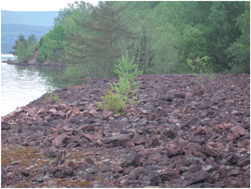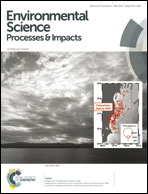Mobility of radionuclides and trace elements in soil from legacy NORM and undisturbed naturally 232Th-rich sites
Abstract
Investigation of radionuclides (232Th and 238U) and trace elements (Cr, As and Pb) in soil from two legacy NORM (former mining sites) and one undisturbed naturally 232Th-rich site was conducted as a part of the ongoing environmental impact assessment in the Fen Complex area (Norway). The major objectives were to determine the radionuclide and trace element distribution and mobility in soils as well as to analyze possible differences between legacy NORM and surrounding undisturbed naturally 232Th-rich soils. Inhomogeneous soil distribution of radionuclides and trace elements was observed for each of the investigated sites. The concentration of 232Th was high (up to 1685 mg kg−1, i.e., ∼7000 Bq kg−1) and exceeded the screening value for the radioactive waste material in Norway (1 Bq g−1). Based on the sequential extraction results, the majority of 232Th and trace elements were rather inert, irreversibly bound to soil. Uranium was found to be potentially more mobile, as it was associated with pH-sensitive soil phases, redox-sensitive amorphous soil phases and soil organic compounds. Comparison of the sequential extraction datasets from the three investigated sites revealed increased mobility of all analyzed elements at the legacy NORM sites in comparison with the undisturbed 232Th-rich site. Similarly, the distribution coefficients Kd (232Th) and Kd (238U) suggested elevated dissolution, mobility and transportation at the legacy NORM sites, especially at the decommissioned Nb-mining site (346 and 100 L kg−1 for 232Th and 238U, respectively), while the higher sorption of radionuclides was demonstrated at the undisturbed 232Th-rich site (10 672 and 506 L kg−1 for 232Th and 238U, respectively). In general, although the concentration ranges of radionuclides and trace elements were similarly wide both at the legacy NORM and at the undisturbed 232Th-rich sites, the results of soil sequential extractions together with Kd values supported the expected differences between sites as the consequences of previous mining operations. Hence, mobility and possible elevated bioavailability at the legacy NORM site could be expected and further risk assessment should take this into account when decisions about the possible intervention measures are made.


 Please wait while we load your content...
Please wait while we load your content...